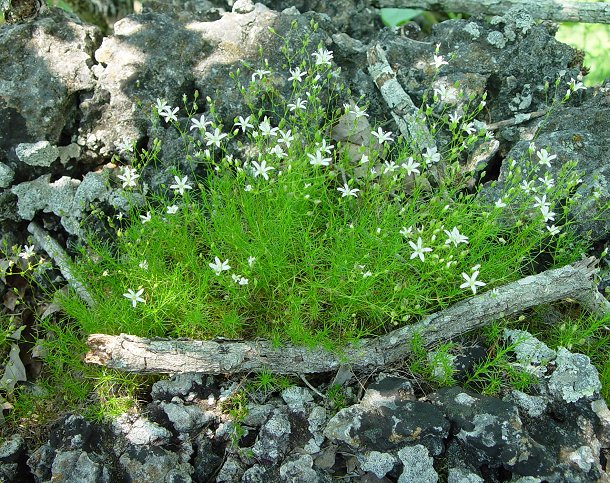Sabulina michauxii (Fenzl) Dillenb. & Kadereit
Rock Sandwort

Native
CC = 9
CW = 5
MOC = 22
© DETenaglia
Sabulina michauxii (Fenzl) Dillenb. & KadereitRock Sandwort | |
 |
Native CC = 9 CW = 5 MOC = 22 |
© DETenaglia |
|
Family - Caryophyllaceae Habit - Perennial forb, often with a somewhat woody, branched rootstock. Stems - 8-40 cm long, often with erect or ascending branches from a spreading, somewhat matted branch system, occasionally the ascending stems originating directly from the rootstock, the ascending portions unbranched or less commonly few-branched, glabrous.
Leaves - Opposite, 0.8-3.0 cm long, 0.5-1.8 mm wide, narrowly linear, stiff and leathery, often spinelike at tip, dense and overlapping below the stem midpoint, with axillary clusters of leaves at most nodes. Nodes concentrated in lower half of stem.
Inflorescences - Flowers in open or dense panicles, the stalks 0.3-6.0 cm long, glabrous, the bracts with thin, white margins. Flowers - Sepals 3-6 mm long (not becoming elongated at fruiting), the lobes lanceolate to ovate, angled or more commonly tapered to a sharply pointed tip, the surface with 3 prominent nerves or ridges. Petals 4-9 mm long, rounded to more or less truncate at the tip.
Fruits - Capsules 3-4 mm long, usually shorter than the calyx, dehiscing by 3 teeth. Seeds 0.8-0.9 mm wide, the surface tuberculate, black, not shiny.
Flowering - May - July. Habitat - Glades, bluffs, ledges, usually on limestone or dolomite substrate. Origin - Native to the U.S. Lookalikes - Minuartia patula. Other info. - This limestone bluff and glade species occurs in scattered locations in Missouri, mostly south of the Missouri River. It is found in scattered locations across other parts of the continental U.S., defining several somewhat disjunct populations. The plant has a long tough root that enables in to grow in cracks and holes in rocky substrates. It is easily identified by its small white flowers and characteristic leaves. These are needlelike and dense on the lower portion of the stem, and virtually absent on the upper stems. The appearance is very distinctive. Photographs taken near Jam Up Cave, Shannon County, MO., 6-22-03 (DETenaglia); also at St. Joe State Park, St. Francois County, MO, 6-2-2013 (SRTurner). |